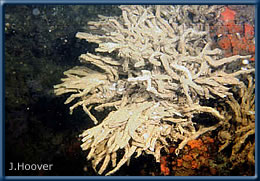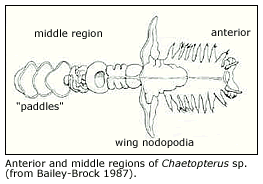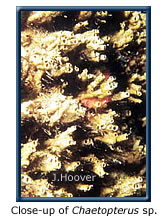

Chaetopterus sp.

Sabellestarte spectabilis

Salmacina dysteri
Chaetopterus sp.
 Parchment
worm
Parchment
worm
Phylum Annelida
Class Polychaeta
Family Chaetopteridae
Description
These large worms live in tough tubes (often described as parchment-like)
that are usually coated with fine mud. The body of this species is divided
into 3 regions. The anterior region has 8 to 12 segments and a pair of
short, tapered palps and a pair of eyes. The middle region is made up
of segments, the second of which has a pair of winglike notopodia; the
third, fourth and fifth have fan-shaped paddles. The posterior region
has 9 to 20 or more segments bearing sticklike notopodia with knobbed
ends. The middle and posterior regions are green or black. Tubes are are
approximately 8 to 12 cm long and 0.5 cm to 1 cm wide (from Bailey-Brock
1987).
 Habitat
Habitat
Aggregations typically occur in shallow, silty water attached to solid
substrates such as rock, coral rubble, and pier pilings, but can occasionally
be found in a variety of reef habitats. Clumps of worms tubes are also
found partially buried in sediments in protected areas.
Distribution
Hawaiian Islands
Throughout main Hawaiian Islands, especially in harbors and embayments
Native Range
Unknown
Present Distribution
Probably worldwide in warm and temperate seas
 Mechanism
of Introduction
Mechanism
of Introduction
Unintentional, as fouling on ships' hulls or planktonic larvae in ballast
water
Impact
Fouling organism. Ecological impact unstudied, but observations suggest
competition for space with other invertebrates. In some areas (e.g., Pearl
Harbor), Chaetopterus can form dense monospecific
aggregations which undoubtedly affect the abundance and distribution of
animals in the habitat.
Ecology
Feeding
Chaetopterus live in irregularly U-shaped
tubes through which they pump water, filtering out organic particles with
a mucus bag that acts as a sieve. Nodopodial paddles create the water
current through the tube, while other segments bear suckers to help anchor
the worm in position. When the mucus bag becomes clogged with particles,
it is rolled into a ball, passed to the mouth by a ciliary tract and ingested,
then a new bag is produced.
Reproduction
Certainly contributing to its success as an invader is the chaetopterids
power of regeneration. Any single segment from among the first 14 can
regenerate anteriorly and posteriorly to produce a complete worm. Chaetopterid
worms are dioecious (having separate sexes). Gametes arise from proliferation
of cells from the peritoneum, these cells are released into the coelom
where they mature, before being released. After a short time in the plankton,
the trochophore larvae settle and mature.
Remarks
Bailey-Brock (1976) noted that Chaetopterus
sp. was abundant in Kaneohe Bay on the alga Dictyosphaeria cavernosa.
Bailey-Brock (1987, as C. variopedatus) noted it was also "a frequent
component of fouling communities". Coles et al. (1999) record its
continued presence in Pearl Harbor (1996 collections). It was not, curiously,
reported in Hartman (1966) nor in the works of Edmondson, covering the
biota of the Islands up to the 1940s. It may have been introduced during
or after World War 11, or indeed even much later in the 1960s or early
1970s. We regard it as cryptogenic.
References
Bailey-Brock, J.H. 1976. Habitats of tubicolous polychaetes from the Hawaiian
Islands. Pacific Science. 30:69-81.
Bailey-Brock, J.H. 1987. Phylum Annelida. in: Reef and Shore Fauna of
Hawaii, Section 2: Platyhelminthes through Phoronida and Section 3: Sipuncula
through Annelida, D.M. Devaney and L.G. Eldredge, eds. Bish. Mus. Spec.
Pub. 64(2 and 3): 216-454.
Coles, S.L., R.C. DeFelice, L.G. Eldredge, and J.T. Carlton. 1999. Historical
and recent introduction of nonindigenous marine species into Pearl Harbor,
Oahu, Hawaiian Islands. Marine Biology. 135:147-158.
Hartman, O. 1966. Polychaetous annelids of the Hawaiian Islands. Occ.
Pap. B.P. Bish. Mus. 33(11): 163-252.
© 2002 Hawaii Biological Survey, Bishop Museum
contact